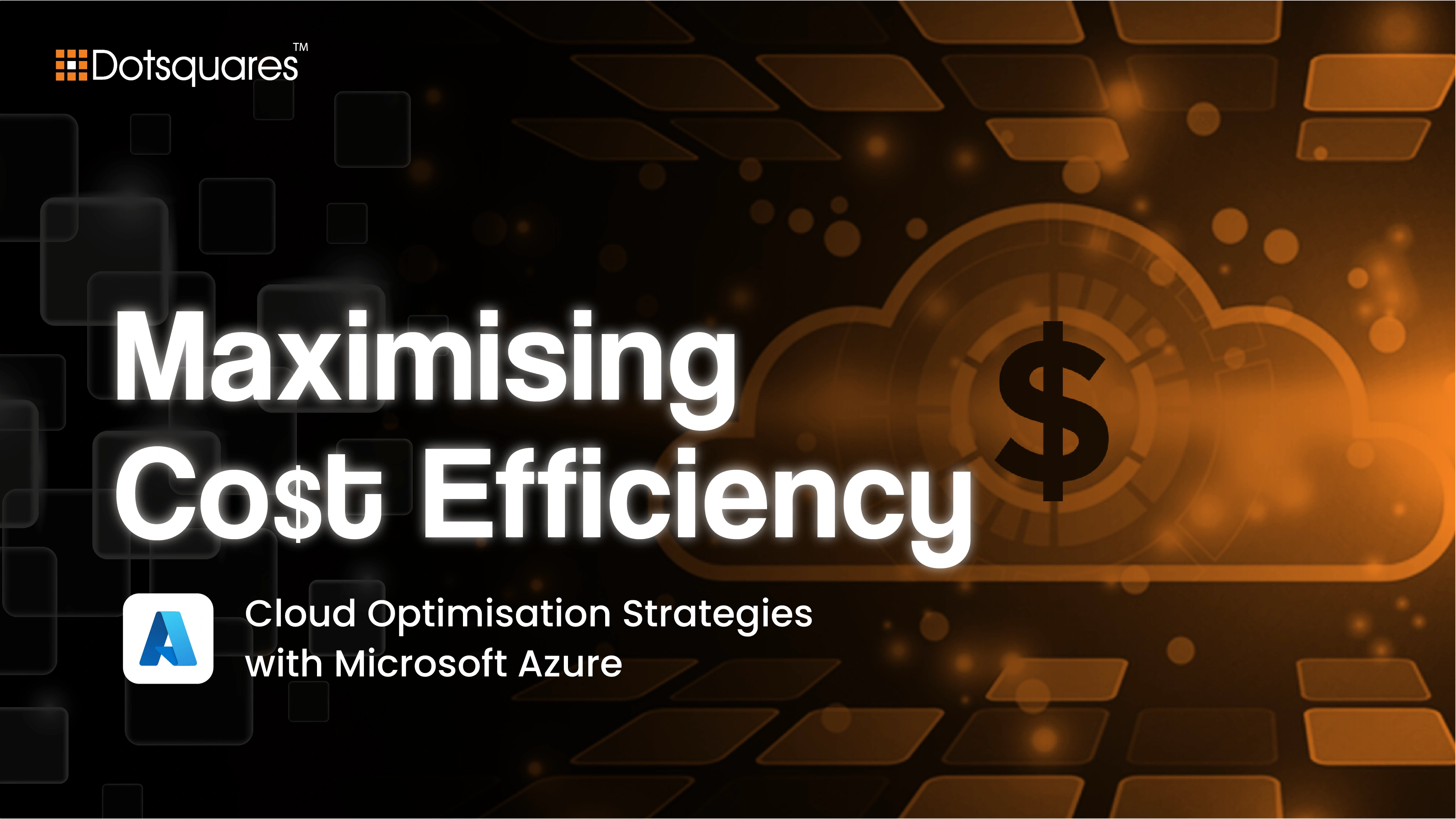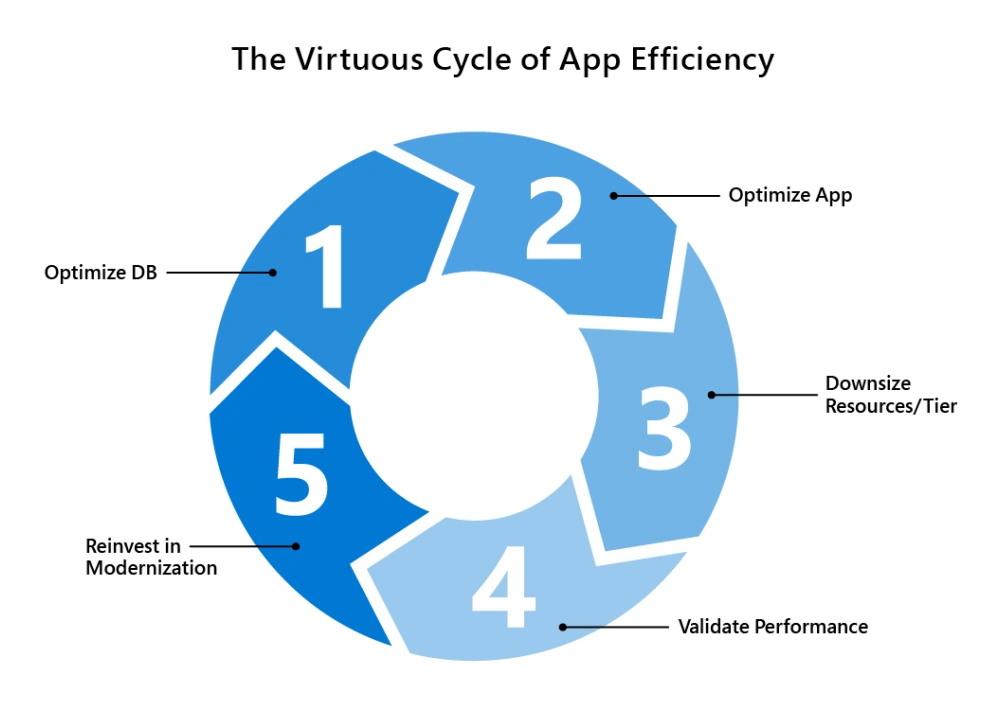


Cloud computing has transformed how businesses operate by making scalable and flexible computing resources available on demand. One of the leading cloud platforms, Microsoft Azure, provides a wide range of services to help businesses go big in modern times, and it is helping them realise their true potential so they can meet their business goals.
The use of the cloud is increasing across industries and many businesses are using this for streamlining business operations. The need of the hour is to implement cost-cutting strategies and with this, businesses can ensure they are getting the most out of their cloud resources while minimising waste.
Cloud efficiency is undeniably very critical for every business. It includes factors like cost optimisation, carbon reduction, and energy optimisation. With this, businesses can control cloud spending, reduce environmental impact, and improve application performance.
Every cloud environment needs an adequate approach to reduce costs. Here are some of the cloud optimisation strategies with Microsoft Azure that businesses can use to save money and get the most out of their cloud investments.
Right-sizing is an important strategy for reducing cloud costs. It includes optimising the size of cloud resources to manage the right balance between performance and spending. Businesses often use resources that are larger than what their platforms require. It results in unnecessary costs which are not helping their business.
Microsoft Azure provides tools like Azure Monitor and Azure Advisor for resource utilisation. With these tools, businesses can monitor how their business is using the cloud. These provide insights into resource usage patterns so businesses can understand and get better with their utilisation.
In a business, many times there are cloud resources that are over provisioned or underutilised. With these Azure tools, businesses can identify those resources and resize them by analysing this data.
For example, businesses can downsize virtual machines (VMs) or databases to match their actual workload requirements. Moreover, it can result in significant cost savings. Microsoft Azure also offers tools such as Azure VM Reserved Instances and Azure Database Reserved Capacity. These tools enable businesses to commit to longer-term use of VMs or databases in exchange for discounted pricing. Businesses can reduce cloud costs without sacrificing performance by right-sizing their resources and leveraging reserved instances.
It is critical to identify and remove any cloud resources that are unused or unnecessary in a business. This process can help in lowering costs and optimising cloud resources. When a business is dealing with multiple workloads or complex projects, resources are frequently created as a transitional step and are often forgotten. This results in enhanced costing with resources that are of no use.
Businesses can perform regular clean-up operations to identify and terminate unused resources such as VMs, storage accounts, and network resources. Microsoft Azure offers tools such as Azure Resource Graph and Azure Cost Management and Billing to assist businesses in identifying and tracking unused resources.
Furthermore, businesses can use resource tagging and naming conventions techniques to better manage and track their resources. It makes it simplified to identify and decommission unused resources. With this process, businesses can optimise their cloud costs, improve resource utilisation, and reduce unnecessary spending by regularly cleaning up unused resources.
Azure Cloud has options like Azure Reservations and Savings Plans. These allow businesses to commit to long-term usage of specific Azure services or compute resources in exchange for significant cost savings. Businesses can optimise their cloud costs while maintaining flexibility and maximising savings by leveraging Azure Reservations and Savings Plans.
Azure Reservations enable businesses to prepay for VMs, databases, and other Azure resources. It comes with two options where businesses can use it for a year or three-year term, securing discounted prices.
Azure Savings Plans give businesses flexibility where they can commit to a certain amount of cloud usage. This helps them cut costs as discounts are applied automatically when usage exceeds the initial commitment. The Azure savings plan is a flexible pricing model that provides savings with pay-as-you-go pricing. For this, you need to commit to spending a fixed hourly amount on Azure cloud computing services for one or three years.
Azure Reservations and Savings Plans both have the potential to result in significant cost savings. Moreover, it is best suitable for businesses with predictable workloads or long-term commitments to Azure services. Microsoft Azure offers tools such as Azure Cost Management and Billing that can assist businesses in monitoring and managing reservations and savings plans to ensure maximum cost savings.

It is another crucial cloud cost optimisation strategy. Database and application tuning can reduce costs and improve performance. Businesses frequently migrate applications that rely on legacy databases or use out-of-date data handling patterns. It results in slow queries, resource-intensive operations, and unnecessary data exchange. Furthermore, all of these lead to increased costs.
Businesses can use Microsoft Azure to optimise their databases and applications in order to improve performance and lower costs. Microsoft Azure offers many database services, including Azure SQL Database, Azure Cosmos DB, and Azure Database for MySQL/PostgreSQL, all of these services are unique and come with their own set of optimisation features.
It is very easy for businesses to enable performance-tuning features like indexing, query optimisation, data compression, etc. moreover, this process can be done by configuring automatic scaling based on overall cloud usage patterns and these optimisations can significantly reduce database costs by improving query performance and reducing the amount of data that needs to be stored or processed. In addition to this process, businesses can optimise their applications and improve performance.
Every business with Azure Cloud can use Azure Application Insights, which is a performance monitoring and diagnostics service, these are used to identify and resolve performance issues in their digital infrastructure. By using these, businesses can reduce resource consumption, cut costs, ensure optimal performance, and deliver an enhanced and improved end-user experience.
Storage optimisation is another critical aspect of cloud cost optimisation. When a business is dealing with a large amount of data for its needs, storage costs can be high and for this, Microsoft Azure offers a variety of storage options like Azure Blob storage, Azure Files, and Azure Disc storage, each with unique performance features and costs.
Businesses can reduce storage costs by carefully selecting the best storage options for their specific needs. For example, they can implement data lifecycle management policies to move or delete data based on its age or usage patterns.
It has a tiered storage option which allows businesses to store frequently accessed data in a hot tier and infrequently accessed data in a cool or archive tier. Moreover, this provides cost-effective storage options for different data access patterns.
Businesses can also use data compression, deduplication, and encryption to reduce storage costs while maintaining data security. Additionally, Azure Storage Explorer, Azure Monitor, and Azure Cost Management and Billing can be used by businesses to monitor and manage storage usage and costs. It helps them to make informed decisions and optimise their storage costs.
Many businesses operate in a hybrid environment. In this type of infrastructure, some of their digital legacies are stored on-premises and some of it is on the cloud. It is critical for businesses to optimise this hybrid environment in order to achieve cost efficiency. Microsoft Azure offers various services and tools for optimising hybrid cloud scenarios.
Microsoft's Azure Hybrid Benefit allows businesses to use their existing Windows Server and SQL Server licences to run virtual machines in Azure at a discounted rate and itis a crucial factor that can reduce the licensing costs.
Additionally, Azure Arc helps in extending Azure management and governance capabilities to on-premises, multi-cloud, and edge environments. It allows businesses to manage and optimise all of their resources centrally from a single control plane.
Businesses can also save money on data transfers and improve performance by using Azure ExpressRoute. It is a private network connection that connects on-premises to Azure. By optimising their hybrid cloud environment, businesses can ensure seamless integration of on-premises and cloud resources, improve performance, and reduce costs.
Monitoring and governance are critical components of cloud cost optimization. Microsoft Azure offers a variety of tools and services that help businesses effectively monitor and manage their cloud costs.
Azure Cost Management and Billing is an all-in-one cost management and reporting tool that gives businesses insight into their cloud costs, usage, and trends. Businesses can use it to track costs by resource group, subscription, or department. It can be used to set budgets and generate custom cost reports.
Moreover, Azure Cost Management and Billing have a feature named Azure Budgets. It enables businesses to set spending thresholds and alerts to be notified when costs exceed the budget.
For monitoring, Azure has a powerful governance tool called Azure Policy. It allows businesses to define and enforce policies across their Azure resources. Moreover, Azure Policy can be used by businesses to enforce resource naming conventions, implement tagging standards, and restrict resource types or locations. It ensures that cloud resources are provisioned and used in accordance with best practices and cost optimisation guidelines.
Cloud optimisation is critical for businesses to make the most of their Microsoft Azure cloud investments as businesses can reduce costs, improve performance, and increase overall efficiency by implementing effective cloud optimisation strategies. You need to constantly monitor and optimise your Azure resources to ensure ongoing cost optimisation for your cloud infrastructure. Monitoring resource usage, cost trends, and performance metrics on a regular basis can provide valuable insights into areas for further optimisation.
In your business, with Dotsquare's assistance, you can effectively leverage Microsoft Azure to achieve your business goals and gain a competitive edge in today's digital landscape by implementing cloud optimisation strategies. With Azure experts, you can get the best approach and save costs while getting the best possible cloud solutions.
Discover AI agent integration for websites, real use cases, costs, and results. Learn how modern AI agents improve customer experience and scalability.
Keep ReadingWe are now official Progress Partner, delivering intelligent Sitefinity CMS solutions, AI-powered personalisation, & enterprise-grade digital experiences globally.
Keep ReadingDiscover how HubSpot’s AI-powered Smart CRM uses automation, Breeze AI, and integrations to create personalised, human customer relationships.
Keep Reading